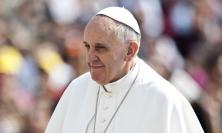Following Pope Francis, James Hanvey SJ argues that the increasing emphasis on the need for the Church to become more synodal is about more than a reshuffle of current structures and processes. ‘Synodality is not just one particular model according to which the Church could be organised; it is the expression of the Church’s existence and mission grounded in the mystery of the divine life.’
With the papacy of Pope Francis, the words ‘synod’ and ‘synodality’ have gained a new prominence in our ecclesial vocabulary and thinking. Of course, synodality is neither a new concept nor experience for the Church. We see it at the Church’s very beginning, in the momentous Council of Jerusalem, which approved Paul’s mission to the gentile world. In one form or another, synods have been a feature of the Church’s life through the centuries.
Background
The Synod of Bishops was established by Pope Paul VI in 1965 and episcopal synods have since become a regular feature of the Church. It was intended that a synod would consist of bishops,
chosen from various parts of the world, in ways and manners established or to be established by the Roman pontiff, [to] render more effective assistance to the supreme pastor of the Church in a deliberative body … it shall be acting in the name of the entire Catholic episcopate, it will at the same time show that all the bishops in hierarchical communion partake of the solicitude for the universal Church. (Pope Paul VI, Christus Dominus [1965], §5)
For almost sixty years, the synod has given practical expression to the vision of collegiality expressed in the teaching of the Second Vatican Council, especially Lumen gentium, which offered a rich and profound understanding of the mystery, order and mission of the Church. This was further developed in the Council’s teaching on the office of the bishop in Christus Dominus. Convened cum et sub Petro (‘with and under Peter’), the synods have continued to reflect on a wide range of themes that are important for the life of the post-conciliar Church, the most recent being on Marriage and Family Life (2014/5), Young People, Faith and Vocational Discernment (2018), and the Pan-Amazon Region (2019). The next synod (2023) will be on synodality itself.
The actual process of the synod is designed to preserve the delicate balance between the practice of episcopal collegiality and the unique teaching and governing ministry that the papacy exercises within the Church. This was already a sensitive issue in the Council and the tensions can be seen in Lumen gentium. Normally, the synod would present the fruits of its discussion to the pope. He would then include their findings in a synodal exhortation, representing his own developed teaching or reflections in light of the synod. Although the synod is constituted by bishops gathered in communion, that does not preclude them from inviting contributions from experts or representatives of groups who may have a particular expertise relevant to the matters under discussion.
Since Vatican II, the establishment of the Synod of Bishops with its regular meeting has contributed to a deepening recognition of the synodal nature of the whole Church. As is made clear in the 2007 ‘Ravenna Document’ of the Joint International Commission for the Theological Dialogue between the Roman Catholic Church and the Orthodox Church, synodality was already a central part of the ecclesiology of the Orthodox Churches. Its recovery and development by the Western Church holds significant ecumenical promise when it comes to the desire for reconciliation between these great traditions. Synodality has other important dimensions as well but, first, it will be helpful to explore its meaning and practice in more detail.
Some important theological features
From the beginning of his pontificate, Pope Francis clearly grasped the importance of developing a truly synodal Church. This is not just a legitimate development of the insights of the Council, it is part of Francis’ vision of a Church that lives in mission. Such a Church is one that follows the Risen Lord into a deeper ministry of salvific love for a wounded and vulnerable world.
Synodality is a way of realising the gifts of the whole body of Christ through the service of mission, but it is also a way of healing the wounds of the Church itself. The more completely the Church can live a synodal life, the more it can be a sign to all peoples of the graced ‘fraternity’ or solidarity that is the ultimate reality of humanity, which includes care for ‘our common home.’ Together with other religions and nations, whatever their governing philosophy and commitments, the Church is committed to working for the cultivating of a common home in which all have the means to flourish. This is not some utopian ideal; it springs directly from our faith in Christ, who sacrificed his life for the ‘life of the world’. The Church knows that humanity cannot achieve the purpose that God desires for it independently of God’s grace, of which the Church herself is an active source and sign.
Synodality, then, is not just one particular model according to which the Church could be organised in a more efficient, consultative and managerial way; it is the expression of the Church’s existence and mission grounded in the triune mystery of the divine life. It points to the ultimate ‘communio’ of all creation which cannot happen without the communio of humanity. Ultimately, as the opening hymn of Paul’s Letter to the Ephesians expresses it, Christ is the one who not only brings all things together but sustains them in their unity (Eph 1:10).
However, even though synodality has such theological ground and depth it must also be given operational form and expression in the charisms, offices and life of the Church at all levels. The Canadian Jesuit philosopher and theologian, Bernard Lonergan speaks of the process by which the Church comes to understand itself and, in so doing, becomes constituted more and more as Church. This is the work of the Holy Spirit, and it reminds us that the Church, too, is always on a journey of becoming (‘ecclesiogenesis’) perfected in the kenosis of worship and mission. As Lonergan recognises, the Church itself is a ‘redemptive process’, so synodality has both a soteriological force, as well as the eschatological force that drives the Church towards its becoming. Seen in this light, synodality cannot be other than part of the Church’s life and way of proceeding at all levels.
The task, then, which Pope Francis has taken up is one of assisting the whole Church in realising her synodal nature. This will go beyond episcopal conferences and reach into the normal life of each diocese and parish. It will require us to discover and develop those ways in which all the members of the Church can participate in her synodal life, not just formally in its structures but in her spirituality and mission. Synodality cannot be just a feature of the Church’s life, it needs to become the way in which we are Church.
Towards synodal conversion and spirituality
For all of us, synodality will entail a process of conversion, a discovery of the way in which the Spirit is active in the life of the community: inviting us to new or alternative ways of understanding and interaction beyond those of our normal social, political and even ecclesial habits; and moving us to overcome the barriers of mistrust and the hermeneutics of suspicion which have come to mark the norm of our culture. In other words, synodality asks us to enter into something more than reform or development. It asks us to seek the grace and courage to make the Church an authentic community of love, with an openness to that which is other, a willingness to serve rather than rule, and a desire to follow Christ. We adhere to his truth not only for our own salvation but as the hope of all women and men, especially those forgotten, oppressed and exploited, those ‘excluded from the banquet of life.’ Synodality asks us to fall in love with the Church again and to love her as Christ does.
Even from this brief sketch, we can see that Pope Francis’ emphasis on synodality does not simply reflect a personal preference or view, but stands within a deep theological tradition whose recovery began with Vatican II. The pope recognises that synodality is a profound movement of the Holy Spirit. Out of this central perception of the Holy Spirit’s activity in establishing, developing and sustaining the synodal character of the Church, Francis believes we must find ways of attending to the witness of the Spirit who is active in the whole people of God. Essentially, this requires humility and freedom to discern where and how that same Spirit is leading. This is why the pope constantly appeals to the Church’s charism of discernment and stresses that the sensus fidelium – as indicated in Lumen gentium §12 – is the gift of unerringly recognising the truth of faith and adhering to it. It is a gift that belongs to the whole people of God by virtue of their baptism.
It is critical that the correct understanding of synodality is realised in the whole Church, so that we do not confuse the sensus fidelium with a political or social process of achieving agreement, representing a majority opinion or even a consensus. The capacity to recognise and affirm the truth of faith is the prophetic office of Christ which belongs to the whole people of God; it cannot be appropriated to the laity alone. It therefore presupposes and requires an active dialogue of discernment throughout the whole Church, in which the final charism of discernment rests with the pope and the bishops. As the bishops cannot act independently of Peter in discerning matters of faith, neither can the episcopacy act without consulting the faithful. In other words, it is a discernment of the whole body and of the universal Church. The characteristics of this process sketched in Lumen gentium §12 are instructive if brief: (a) the ‘supernatural’ gift of discernment is realised by the whole people of God; (b) it requires agreement; (c) it is an action of the Holy Spirit guided by the ‘sacred teaching authority’ and, as such, it also confers and requires the obedience of God’s people, which is part of their witness to the truth; (d) it places discernment within the continuity of apostolic tradition and the witness of holiness through history; and (e) it is also recognised by the fruits that it produces: namely, a deeper understanding of the mystery of revelation and a greater effect in the life of the community and that of the individual believer.
If the Church is to realise the fullness of this gift in the witness of her life and teaching, then we must discover and develop ways in which the holistic nature of sensus fidelium can be realised and taken up into all of the ecclesial structures that order the community’s life, teaching and mission. In coming to understand and express the relational integrity of the charism of truth and the capacity for faithful witness that the whole people of God possesses in mission, there is still much work to be done. This, too, is part of the unfolding process of synodality.
Synodal virtues of faith, hope, love
When trying to work our way through all these questions, it can be helpful to think in terms of three dimensions of synodal reality: the theological dimension, the spiritual dimension, and praxis. Ideally, what we should be looking for is a synthesis of all three. Praxis alone will not express the depth and reality of synodality if it is not grounded in a rich and creative theology. The resources of our Trinitarian faith help us to grasp, by analogy, the nature of unity in relationality and the dynamic ordering of the soteriological mission: the Son is sent by and from the Father in the power of the Holy Spirit, who proceeds from both the Father and the Son, as the gift of life-giving grace and truth. Neither the theology nor the praxis of synodality will bear lasting fruit if they are not nourished by the life of the Spirit and do not reflect something of this graced relationality.
It is this same Spirit that anoints the Church with so many charisms for her life and mission. In whatever form they take, they will always manifest the three great theological virtues of faith, hope and love. These nourish and sustain the life of every Christian and they become the hallmark of the Church’s presence and her work of redeeming and sanctifying. Interestingly, they are also the three features of consolation that St Ignatius identifies in the Spiritual Exercises (§316). The virtues have relational and practical consequences, and a brief consideration might prove helpful, not only for the discernment that is so integral to the synodal process but in developing a community which is journeying together in Christ.
Faith: When our relationships express our faith, we will be committed to each other on the journey, no matter how long or what difficulties may occur. This is because our faith is not just faith in one another and in the sacramental structures of the Church, but it is faith in God who is present and guides everyone who is a member of the community of faith.
Faith also gives us the ability not to get diverted by conflicts and divisions, but to come to understand them, and what lies behind them, so that rather than a source of despair and paralysis they can become a means of advancing in God’s service. Faith is the courage to persevere, keeping our minds, hearts and wills always focused on and open to God.
Hope: This is one of the great gifts of the Holy Spirit. It fills us with creativity and opens new possibilities. Hope always allows us to begin again. It is not afraid of failure but, because it is always open to the future, which is God’s gift, it has the power to learn from failure and to grow in understanding.
Christian hope is not the same as human optimism. Christian hope does not arise from any natural disposition, nor is it the product of some utopian vision whose credo is a doctrine of endless progress by which the future will be better than the past. A man-made hope will always end as the fragments of a ship-wrecked dream washed up on the shores of an unredeemed history.
Christian hope is the Spirit’s gift, itself the assurance and the witness of the Risen Christ and the Father’s inexhaustible love for us and all creation. It is God’s future for us that comes to meet us as promise and possibility, a future which is already realised in the Risen Christ. This gift of hope enables us to lay hold of these graced possibilities to create in our lives and our different circumstances the first fruits of the Kingdom of God.
The virtue of hope moves us to look always beyond ourselves to the One in whom we hope. It gives us the courage to face reality and its truth without despair and, no matter how deep the valley of darkness, to find that Christ is already present and that his grace is already working something new. Our grace is to work with him in hope.
However, in his teaching about the discernment of spirits, St Ignatius of Loyola warns us that the ‘enemy of human nature’ will want to work against all the theological virtues. One of the most vulnerable and easily disturbed is the gift of hope. On the one hand, this can happen through converting the gift of hope into a human optimism which distracts it from Christ and makes it into either a sort of personality trait or a learned disposition through some alternative philosophy of well-being. On the other, the disturbance can happen paradoxically by generating an anxiety about the future, which moves us to place our ‘hope’ in the past. In a recent audience, Pope Francis identified this in his commentary on Paul’s Letter to the Galatians. The Galatians were faced with a crisis of authority: who were they to follow, the ‘new preachers’ or Paul? The ‘new preachers’,
present themselves not primarily to announce the Gospel of God who loves man in Jesus, Crucified and Risen, but to insist, as true ‘keepers of the truth’ — so they call themselves — on the best way to be Christians. And they strongly affirm that the true Christianity is the one they adhere to, often identified with certain forms of the past, and that the solution to the crises of today is to go back so as not to lose the genuineness of the faith. Today too, as then, there is a temptation to close oneself up in some of the certainties acquired in past traditions. But how can we recognize these people? For example, one of the features of this way of proceeding is inflexibility. Faced with the preaching of the Gospel that makes us free, that makes us joyful, these people are rigid. …..Following the teaching of the Apostle Paul in his Letter to the Galatians will help us understand which path to follow. The path indicated by the Apostle is the liberating and ever-new path of Jesus, Crucified and Risen; it is the path of proclamation, which is achieved through humility and fraternity — the new preachers do not know what humility is, what fraternity is. It is the path of meek and obedient trust — the new preachers know neither meekness nor obedience. And this meek and obedient way leads forward in the certainty that the Holy Spirit works in the Church in every age. Ultimately, faith in the Holy Spirit present in the Church carries us forward and will save us. (Pope Francis, General Audience, 23 June 2021)
Love: Love, as St Paul reminds us, is the greatest of the Spirit’s gifts because God is Love (1 Cor 13). When we are loved, we experience consolation and, when we love, we are ministers of Christ, the Consoler. This love has the power to overcome all hatred because it refuses to be drawn into the economy of enmity and the power struggles of dominance and subjection. Love seeks only the good of the other and it refuses to accept anything less. This gives to such love a strong, generous humility and a fierce commitment to the truth; a freedom to speak and to act, to forgive and to reconcile; an audacity to gift to another without looking for reward or recognition but only to delight the Holy Spirit who is gift.
This way of loving tends not to draw attention to itself, yet we know it is present by the life that it produces and the fruit that it sustains. As it is taught in the school of God’s own triune love, it will understand the beauty and the grace of diversity; difference need not be a threat but is itself a gift when it comes to love. It will recognise the openness, reception and vulnerability of the other and claim responsibility for them, for their truth and the work that God has also called them to do. In this way, we can begin to discover how this gift of love gives us a new mission, not only with regards to each other, but to build up the ‘koinonia’ – the fellowship – to which Christ calls us in his Church.
If we take these theological virtues as our starting point, they can also help us with the process of discerning the path of the Holy Spirit that brings life to the community and its work. They are operative all through the criteria sketched in Lumen gentium §12 and we can begin to see how they will also be active in the synodal process. An application of the theological virtues as part of the way in which we discern as well as act, can serve to guide us in our thinking and in our relations. In this way we may become a Church walking in consolation, even when members experience persecution, suffering and martyrdom.
By the same token, we can recognise those patterns and forces that bring desolation because they are opposed to faith, hope and love. Often well disguised, nevertheless they will sow doubt and division, substituting ideology for a faith that humbly searches for an ever-deeper understanding of the mystery of salvation unfolding in history. The presence of suspicion, ready condemnation of the other who differs from us, and all the different mechanisms by which individuals and groups can be socially and spiritually assassinated, repeating the ancient sin of Cain and Abel; the constant jockeying for power and influence, the creation of circles of inclusion and exclusion and all the other strategies of control – whenever we see these, then we know we are living in a community travelling in desolation.
With the Spirit’s gift of life in faith, hope and love comes the gift of responsibility to resist and overcome those patterns of fear and negativity which do not nourish the mystical body of Christ but continue to wound it. When we recognise these sources of desolation, we also recognise our need of healing and forgiveness, and this is the first step upon the way of the Spirit.
The theological virtues of faith, hope and love are the bedrock of all Christian life and praxis. They guide the service of authority, and they open the way to participation in that they belong to every member of the body of Christ, and every member has the right to be heard in faith, hope and love. They condition all our relationships – whether in the parish or the synod – and they are the road on which we meet the world in its doubts, oppositions, indifference and suffering. They are not only the convergent paths of synodality, they are the convergent paths of Christian life and mission; they are the Spirit-given graced ways of our conversion together into the fullness of life in Christ.
James Hanvey SJ is Secretary for the Service of the Faith for the Society of Jesus.






